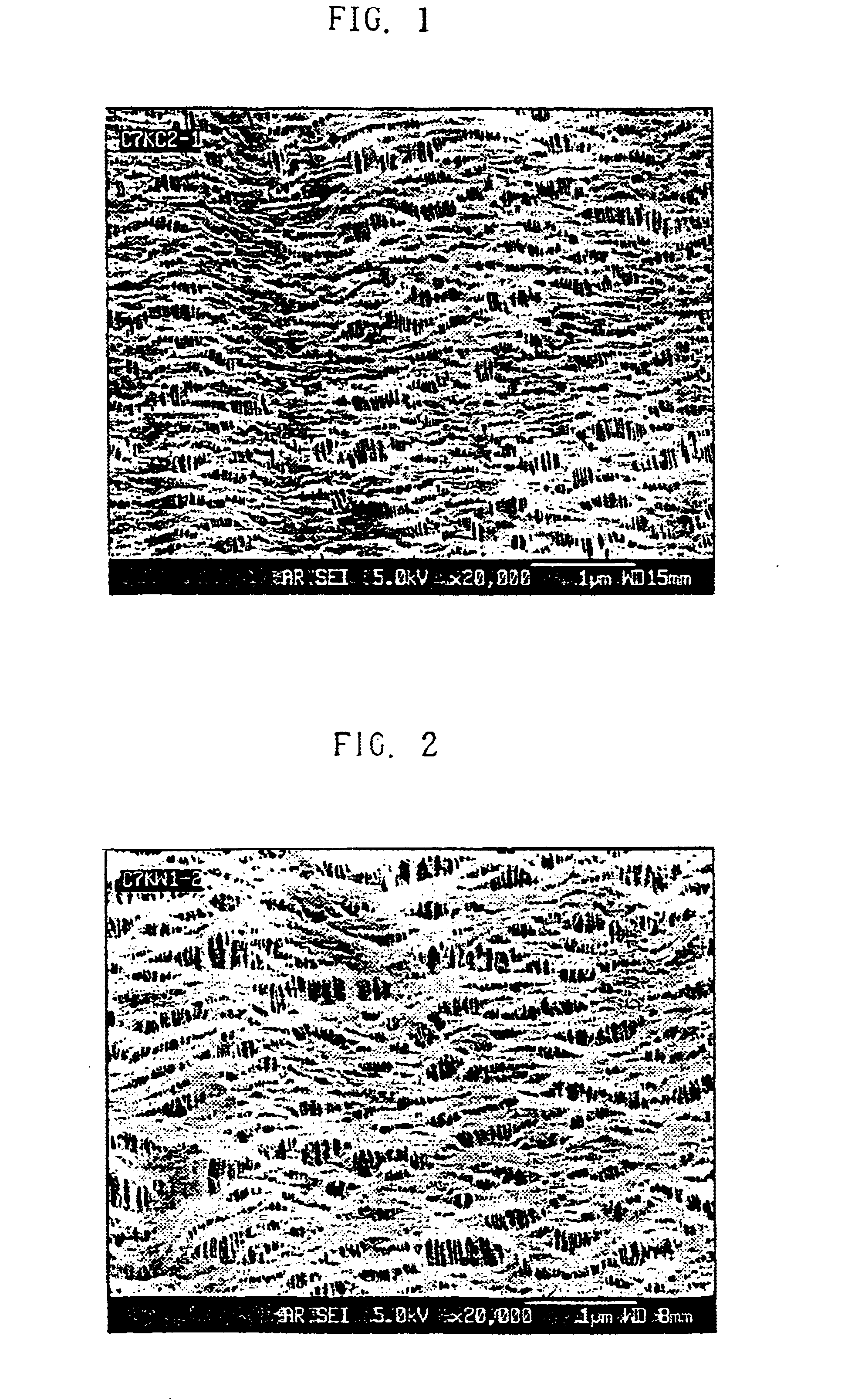Methods for reforming polymer surface for improved wettability
a polymer and surface technology, applied in the field of polymer surface reforming, can solve the problems of low wettability with electrolyte, cellulose or non-woven fabric used in the conventional battery cannot be used, affecting the performance and safety of the battery by its mechanical characteristics, etc., and achieves easy surface reforming, good working environment, and easy application
- Summary
- Abstract
- Description
- Claims
- Application Information
AI Technical Summary
Benefits of technology
Problems solved by technology
Method used
Image
Examples
example 1
After a polyethylene separator manufactured by a dry process was put into a vacuum chamber maintained under the condition of 10.sup.-4 torr, hydrogen ion particles (H.sub.2.sup.+) were irradiated on both sides of membrane using an ion gun, wherein the energy of the ion beam was 500 eV and the dose of ion irradiation was 5.times.10.sup.14 ions / cm.sup.2. The obtained microporous membrane had a 4.2 second water absorption rate and with a mixture of ethylene carbonate (EC) and dimethyl carbonate (DMC), and showed good wettabilities with electrolyte No. 1 having mixing weight % of ethylene carbonate (EC): dimethyl carbonate (DMC) of 4:6, electrolyte No. 2 having mixing weight % of 5:5, and electrolyte No. 3 having mixing weight % of 6:4. Furthermore, the contact angle could not be measured on electrolyte No. 3 showing the greatest polar intensity because the electrolyte solution had permeated into the membrane, which means that the membrane was fully wetted with electrolyte solution.
A sc...
example 2
After a polyethylene separator manufactured by a wet process was put into a vacuum vat maintained under the condition of 10.sup.-4 torr as in example 1, hydrogen ion particles (H.sub.2.sup.+) were irradiated on both sides of membrane using an ion gun, wherein the energy of the ion beam was 400 eV and the amount of ion irradiation was 1.times.10.sup.15 ions / cm.sup.2. The obtained microscopic pore membrane had a 2.5 second water absorption rate. The wettability test on the three electrolytes of electrolyte No. 1, electrolyte No. 2, and electrolyte No. 3 as in example 1 all showed good wettabilities. Furthermore, the contact angle could not be measured on electrolyte No. 3 showing the greatest polar intensity because the electrolyte solution had permeated into the membrane, which means that membrane was fully wettted with electrolyte solution.
example 3
After a 3 layer membrane consisting of a top layer of polypropylene, a middle layer of polyethylene, and bottom layer of polypropylene was put into a vacuum chamber maintained under the condition of 10.sup.-4 torr as in example 1, hydrogen ion particles (H.sub.2.sup.+) were irradiated on both sides of membrane using an ion gun, wherein the energy of the ion beam was 900 eV and the dose of ion irradiation was 1.times.10.sup.15 ions / cm.sup.2. The obtained microporous membrane had a 4.8 second water absorption rate. The wettability test on three electrolytes of electrolyte No. 1, electrolyte No. 2, and electrolyte No. 3 as in example 1 all showed good wettabilities. Furthermore, the contact angle could not be measured on electrolyte No. 3 showing the greatest polar intensity because the electrolyte solution had permeated into the membrane, which means that membrane was fully wetted with electrolyte solution.
PUM
| Property | Measurement | Unit |
|---|---|---|
| contact angle | aaaaa | aaaaa |
| energy | aaaaa | aaaaa |
| energy | aaaaa | aaaaa |
Abstract
Description
Claims
Application Information
 Login to view more
Login to view more - R&D Engineer
- R&D Manager
- IP Professional
- Industry Leading Data Capabilities
- Powerful AI technology
- Patent DNA Extraction
Browse by: Latest US Patents, China's latest patents, Technical Efficacy Thesaurus, Application Domain, Technology Topic.
© 2024 PatSnap. All rights reserved.Legal|Privacy policy|Modern Slavery Act Transparency Statement|Sitemap

